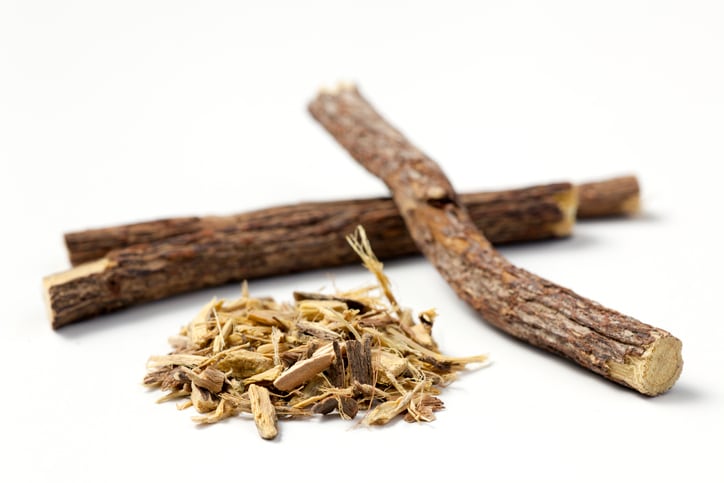The new research was published in the journal Drug Metabolism and Disposition. It was the work of a group of researchers that included Prof. Guido F. Pauli, who is the Norman Farnsworth Professor of Pharmacognosy at the University of Illinois Chicago. Other members of the team were associated with the Linus Pauling Institute at Oregon State University.
Licorice (or liquorice) is the common name of the botanical Glycyrrhiza glabra L.. Extracts of the root and rhizomes of the plant have been used as a medicinal herb and flavoring agent since ancient times. The plant is a member of the bean family and is common to Western Asia, North Africa and Southern Europe.
In supplement applications it is most often marketed to women to aid with the symptoms of menopause.
Potassium depletion, enzyme inhibition
The researchers noted that despite the botanical having GRAS status in the United States, there have been concerns about its safety when high amounts of one of its constituents—glycyrrhizic acid—are involved. Consumption of even small amounts of this organic acid, at the level of 2 mg/day, have been associated with potassium depletion.
However, independent of that well known—though rare—effect, the researchers said that the botanical has been suggested to inhibit certain cytochrome P450 enzymes. If the levels of these enzymes are artificially suppressed, it could potentially result in an overdose of some drugs that are metabolized by those same enzymes. According to the researchers, members of the CYP ‘superfamily’ of enzymes are responsible for metabolizing more than 80% of the commonly prescribed drugs.
To hone in on these issues and leave the potassium depletion question aside, the researchers chose to use a standardized G. glabra extract that had been depleted of glycyrrhizic acid.
For a study population the researchers recruited 19 healthy peri-menopausal and post menopausal American women between the ages of 47 and 66 representing a range of ethnic backgrounds. (Only 14 completed the trial because of pandemic lockdown complications.) While that might seem a small sample, the researchers noted that it is in line with recent botanical/drug interaction studies for red clover and goldenseal.
The participants were restricted from ingesting any foods containing licorice, citrus or caffeine during the study. Citrus has been known to affect one of the enzymes in question, and caffeine was used as one of the enzyme substrates. The subjects were required to refrain from any non study dietary supplements or drugs from two weeks prior to the beginning of the study through its conclusion.
As substrates for the relevant enzymes, the authors used a cocktail of 100 mg caffeine (CYP1A2 substrate), 250 mg tolbutamide (CYP2C9 substrate), 30 mg dextromethorphan (CYP2D6 substrate), and 2 mg alprazolam (CYP3A4/5 substrate).
The subjects took the cocktail every day for a week. On day eight, they added two capsules containing 150 mg of a licorice extract. Each capsule contained 75 mg of a G. glabra extract standardized to 3.1 mg glabridin, 0.55 mg glycyrrhizic acid, 0.50 mg liquiritin, and 0.47 mg isoliquiritin.
They took both the licorice capsules and the substrate cocktail for 14 days. Blood was drawn at baseline, at the end of the 7-day run up period, and again at the end of the study.
No clinically relevant enzyme effects observed
The concentrations of the enzyme substrates were evaluated with pharmacokinetic parameters such as concentration-time curve (AUC), peak serum concentration (Cmax), time to reach peak concentration (Tmax), elimination half-life (T1/2), and oral clearance rate (CL/F).
The researchers concluded that for the amount of licorice extract they were administering, there appears to be little concern about drug interactions. They did observe some effect in the case of caffeine/CYP1A2, but noted that this was probably due to poor dietary compliance, as caffeine is found in so many foods.
“Despite preclinical data predicting pharmacokinetic interactions between G. glabra and cytochromes P450, this investigation indicates that there is no clinically relevant risk of drug interactions for this extract with respect to CYP1A2, CYP2C9, CYP2D6, and CYP3A4/5,” they said.
As far as caveats are concerned, the researchers noted that there is a wide of dosages for the more than 700 licorice-containing products in the market. They chose the 150 mg dose to land within the dosage range of most of the products, but some are far more potent. In addition, some products labeled as licorice in fact contain extracts of two related species — G. uralensis or G. inflata — and the data in this trial cannot be applied to them.
Source: Drug Metabolism and Disposition
DOI: https://doi.org/10.1124/dmd.122.001050
Pharmacokinetic Interactions of a Licorice Dietary Supplement with Cytochrome P450 Enzymes in Female Participants
Authors: Liu J, et al.




